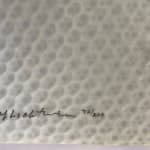



Roy Lichtenstein 1923-1997
Seascape No 1, 1964
Screenprint on transparent Rowlux
Signed in pencil on the reverse
Sheet: 43 x 55.5 cm; 16 7/8 x 21 7/8 in
Printed to the full sheet
Framed: 65 x 77.5 x 3 cm; 25 5/8 x 30 1/2 x 1 1/8 in
Printed to the full sheet
Framed: 65 x 77.5 x 3 cm; 25 5/8 x 30 1/2 x 1 1/8 in
Numbered from the edition of 200. Printed in collaboration with Stephen Poleskie by Chiron Press, New York. Published by Tanglewood Press Inc, New York.
$ 42,000.00
Further images
Roy Lichtenstein's “Seascape No 1” (1964) marks a significant moment in his artistic exploration, as it was the first time he experimented with the innovative material Rowlux. Known for its...
Roy Lichtenstein's “Seascape No 1” (1964) marks
a significant moment in his artistic exploration, as it was the first time he
experimented with the innovative material Rowlux. Known for its ability to
create the illusion of movement and depth through its lenticular surface,
Rowlux allowed Lichtenstein to enhance the dynamic, optical qualities of his
work. In “Seascape No 1”, this material creates a shimmering, otherworldly
effect that aligns with the futuristic and abstract landscape of the print,
giving it a sense of depth and fluidity not achievable with traditional media.
By integrating Rowlux, Lichtenstein expands his commentary on the relationship
between art, technology, and mass production, pushing the boundaries of Pop
Art's use of industrial materials. The use of this material not only heightens
the visual impact but also underscores his interest in how modern technologies
can transform the experience of viewing art, further blurring the lines between
fine art and commercial design. This pioneering work thus reflects
Lichtenstein’s ongoing interest in exploring new mediums while maintaining his
characteristic blend of irony, precision, and cultural critique.
a significant moment in his artistic exploration, as it was the first time he
experimented with the innovative material Rowlux. Known for its ability to
create the illusion of movement and depth through its lenticular surface,
Rowlux allowed Lichtenstein to enhance the dynamic, optical qualities of his
work. In “Seascape No 1”, this material creates a shimmering, otherworldly
effect that aligns with the futuristic and abstract landscape of the print,
giving it a sense of depth and fluidity not achievable with traditional media.
By integrating Rowlux, Lichtenstein expands his commentary on the relationship
between art, technology, and mass production, pushing the boundaries of Pop
Art's use of industrial materials. The use of this material not only heightens
the visual impact but also underscores his interest in how modern technologies
can transform the experience of viewing art, further blurring the lines between
fine art and commercial design. This pioneering work thus reflects
Lichtenstein’s ongoing interest in exploring new mediums while maintaining his
characteristic blend of irony, precision, and cultural critique.
Provenance
Kornfeld and Klipstein Auction, Bern, 15-17 June 1972, lot 671.Private Collection, Switzerland.
Exhibitions
Another impression is in the collection of the MoMA, New York (523.1965.7).3
of
3


